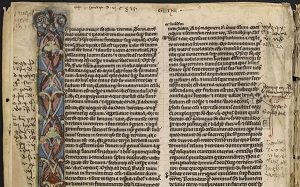 Ancient bibles were made from livestock
Ancient bibles were made from livestock
This is the headline from scienceshot. In a way, it sounds awful. But it’s better than what they used to say. And better still than what some others say.
Why is it so hard to just tell the story without bias and lead with what gets pushed to the very end?
… suggesting that the thin vellum was a question of time-consuming craftsmanship …
The final conclusion from the Daily Mail in the UK –
‘The discoveries of this innovative research therefore enhance our understanding of how these Bibles were produced enormously, and by extension, illuminate our knowledge of one of the most significant text technologies in the histories of the Bible and of Western Christianity.’
And yet – one has to read a whole lot of other stuff in order to get to that conclusion.
First – what scientists used to think –
Extremely thin animal skin pages made the books possible, and manuscript experts have long debated how medieval craftsmen produced such thin sheets. One hint lay in contemporary references to abortivum, or “uterine vellum.” Perhaps, one hypothesis went, the thin parchment was made from the skin of stillborn calves, or from small animals like rabbits.
Just in case it isn’t quite clear – here’s the definition of abortivum –
abortīvum n (genitive abortīvī); second declension
1.abortion, miscarriage
2.that which procures or induces an abortion
Wouldn’t some people love to say that Bibles were made from tissue from any kind of aborted creature?
You might be wondering how they came up with this discovery – what high technology techniques were developed to complete this study –
Now, in a study published online today in the Proceedings of the National Academy of Sciences, scientists have investigated the mystery using protein analysis. First they had to find a nondestructive way to gather samples from centuries-old manuscripts. Their solution: ordinary rectangular art erasers made from polyvinyl chloride, or PVC, a common conservation tool used to remove dirt from old books without damaging the pages. The same effect that attracts your hair to a balloon when you rub it on your head pulled enough collagen onto eraser “crumbs” to yield results in a mass spectrometer, a machine that determines the type of chemicals in a sample.
Another take on the discovery
Getting under the skin of medieval Bibles: Ultra-thin pages were made using a variety of hides and NOT just newborn animal skin
This headline was from the UK based Daily Mail.
But the mysterious material on which the tissue-thin pages of these pocket books were made from has baffled archaeologists for centuries – until now.
In spite of that headline – this quote comes from the middle of the article –
Using a simple eraser to reveal the parchment beneath, the experts have discovered they are not made from abortive or newborn animals as previously thought but were instead the result of a skilled production process.
And yet – the conclusion they reach includes this –
‘Our results suggest that ultrafine vellum does not necessarily derive from the use of abortive or newborn animals with ultra-thin skin, but could equally reflect a production process that allowed the skins of maturing animals of several species to be rendered into vellum of equal quality and fineness.’
On the one hand, they say the Bibles were not made from abortive or newborn animal tissue – according to the research.
the experts have discovered they are not made from abortive or newborn animals
On the other hand, they say the Bibles could have been made from abortive or newborn animal tissue – in spite of the research.
results suggest that ultrafine vellum does not necessarily derive from the use of abortive or newborn animals
Huh?
The experts say it wasn’t that way – but some cannot get beyond saying it anyway.
Finally – regarding the word uterine –
The parchment conservator involved in the study has put the findings to the test by recreating a parchment similar to ‘uterine vellum’ from old skins.
Jimí Vnouček said: ‘It is more a question of using the right parchment making technology than using uterine skin.
And yet – the articles continue to call it uterine vellum, in spite of what the research claims to be fact –
– uterine tissue is not used
– abortive and newborn tissue is not used.
Conclusion
This all reminds me of what we read starting in Exodus 35, where the LORD gave the skills necessary to build The Tabernacle and everything that would be in it –
Ex 36:2 Then Moses summoned Bezalel and Oholiab and every skilled person to whom the LORD had given ability and who was willing to come and do the work. 3 They received from Moses all the offerings the Israelites had brought to carry out the work of constructing the sanctuary. And the people continued to bring freewill offerings morning after morning. 4 So all the skilled craftsmen who were doing all the work on the sanctuary left their work 5 and said to Moses, “The people are bringing more than enough for doing the work the LORD commanded to be done.”
These same scientists that came to the conclusions above would likely disagree with what Moses recorded in Exodus.
Question – Given that – why should we believe them any more regarding the making of medieval Bibles – or the creation of the universe – than we would believe them that God did NOT give the Israelites the skills needed to build His Tabernacle?
Answer – We should not. Yes – listen to the things they learn. Yes – analyze their results. But also consider their motives when it comes to their conclusions.
In the case of the Bibles – the way they were made appears to be unique. Their is no mention of any other books made from this material. It has been an unanswered question for centuries. The old assumptions have been proved wrong. Consider the very real possibility that God gave the people of that time the skills they needed to put together these Bibles – so that His word would be spread. Also consider the very real possibility – especially given the nature of the test process (using an eraser) – that God chose this time to reveal the way these Bibles were made.
People are skilled. The question is where does the skill come from – which can be determined what that skill is used for.
… suggesting that the thin vellum was a question of time-consuming craftsmanship …
You saw the quote from Exodus above – where God gave people the skills to build His Tabernacle.
How about this one from Ezekiel –
Eze 21:31 I will pour out my wrath upon you
and breathe out my fiery anger against you;
I will hand you over to brutal men,
men skilled in destruction.
Who we listen to?
Men skilled in work for God?
Or men skilled in destruction?
Discover more from God versus religion
Subscribe to get the latest posts sent to your email.
